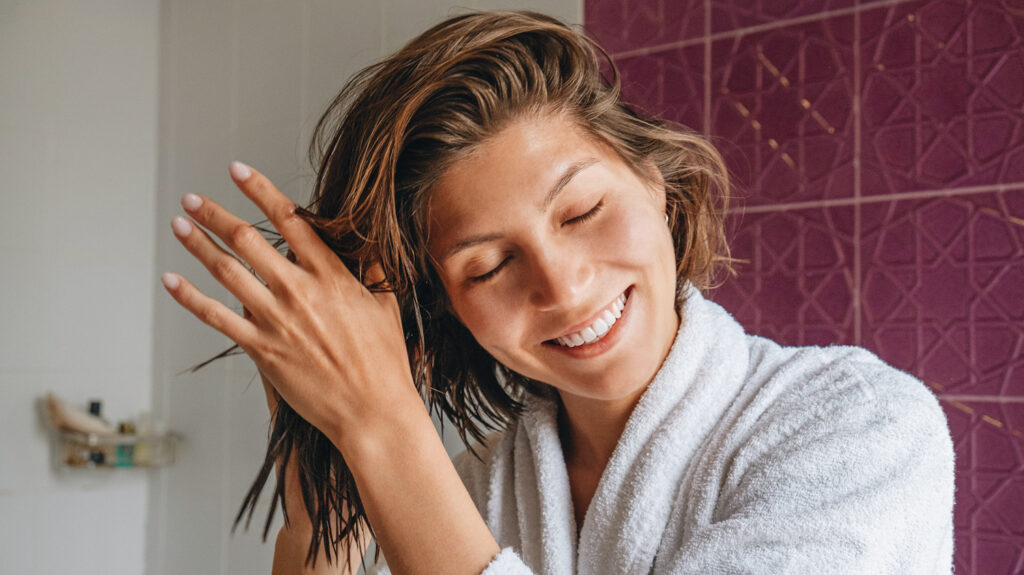Garnier has been trying to green up its image for some time. In 2020, it released its Sustainability Progress Report, detailing its commitment to reducing plastic, using more recycled materials, and focusing on ingredients of “natural origin.” In 2021, it earned cruelty-free certification, and in the same year, it launched its first waterless shampoo bars. Now, the brand is promoting a new “sustainable” product innovation: No Rinse Conditioner.
According to the brand, its No Rinse Conditioner saves 100 liters of water per tube, and its carbon footprint is 92 percent smaller than its traditional wash-out options. (Garnier notes that 63 percent of a wash-out conditioner’s carbon footprint comes from water use.) It’s also packaged in a light-weight cardboard-integrated tube rather than a plastic bottle.
Limiting plastic and water use is definitely progress for a brand under one of beauty’s worst plastic pollution offenders. Its parent company L’Oréal used 140,000 tonnes of plastic in 2018.

What is no rinse conditioner?
While it may imply otherwise, Garnier isn’t inventing the wheel with its latest launch. No-rinse conditioner, or leave-in conditioner as it’s commonly referred to, has been around for some time.
According to cosmetic chemist Kelly Dobos, the key ingredient in Garnier’s formula is stearamidopropyl dimethylamine, “a conditioning agent specifically used for its ability to impart a soft feel to hair without significant buildup.” Many traditional conditioners use quaternary ammonium compounds like behentrimonium chloride, explains Dobos. This is an anti-static, antibacterial, conditioning ingredient that sticks to damaged strands. It requires rinsing out after use to prevent build-up.
Stearamidopropyl dimethylamine is frequently used in products that double as a leave-in conditioner, like Garnier’s own Banana and Shea Intensive Hair Treatment and its Papaya Hair Food Conditioner.
Of course, there is nothing wrong with Garnier using a tried and tested ingredient, or for limiting plastic use, or encouraging consumers to reduce water waste, but the No Rinse branding is seemingly designed to fool consumers into thinking Garnier is going further with sustainable innovation than it actually is, a tactic otherwise known as “greenwashing.”
How beauty greenwashes
The beauty industry is no stranger to greenwashing and Garnier is no exception. For example, it heavily promotes its use of natural ingredients as proof of its sustainability. However, many experts agree that beauty and haircare brands need to move away from relying on the natural world because when we do so, we will always disrupt wildlife and use up natural resources.
Synthetic innovation in the lab is actually a far more sustainable option. “Chemistry allows us to efficiently produce many ingredients with higher purity, greater safety profiles and less disruption to the environment that just isn’t possible otherwise,” explains Dobos.
It shouldn’t go unspoken that Garnier is part of L’Oréal, one of the beauty industry’s biggest conglomerates, and while its sustainability commitments are progress, its primary focus is profit. It has openly acknowledged that several of its products have a high environmental impact, in terms of emissions, water use, land use, and biodiversity, and that better innovation is needed. It says an action plan is “coming,” but in the meantime, it’s business as usual.
Greenwashing is essentially about manipulation. And with the branding around its No Rinse product, Garnier subtly slips the blame on to consumers for wasting water with conditioning products, despite the fact that the brand continues to sell those exact products, all of which list water as their first ingredient. (Most beauty products are between 60 and 85 percent water.)
Adrien Koskas, Garnier’s global brand president, noted in a press release: “there is a discrepancy between our consumers desire to be more sustainable, and actually taking action.” But when you take the above points into consideration, replacing “our consumers” with “Garnier” gives an equally true statement.
In truth, Garnier has made a start towards sustainability, but it needs to make some fundamental changes to its business model before it can be considered an environmentally-considerate brand. Much of that change will come from the top. In 2021, L’Oréal sponsored Climate Week NYC, pledging things like carbon neutrality and the creation of an effective water recycling loop system by 2030. Currently, there is no legislation to hold the beauty industry to account on these goals, so it’s just a matter of wait-and-see.
But good news, there are plenty of sustainable brands in the industry now. And many offer solid beauty and haircare options, which means they don’t contain any water at all. Find our recommendations here.


